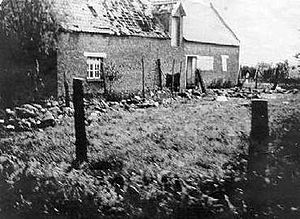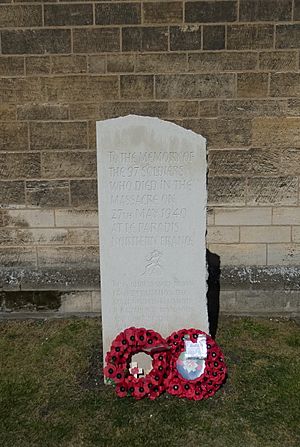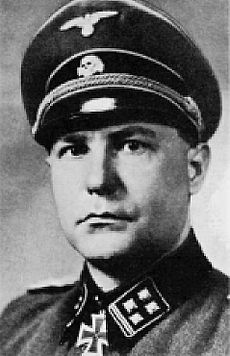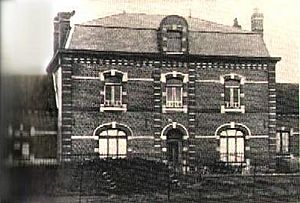Le Paradis massacre facts for kids
Quick facts for kids Le Paradis massacre |
|
|---|---|
 |
|
| Location | Le Paradis village, commune of Lestrem, northern France |
| Date | 27 May 1940 |
| Target | POWs of the 2nd Battalion Royal Norfolk Regiment, 2nd Infantry Division |
|
Attack type
|
Massacre |
| Deaths | 97 |
|
Non-fatal injuries
|
2 |
| Perpetrators | 14th Company, 3rd SS Division Totenkopf
|
The Le Paradis massacre was a terrible event during World War II. It was a war crime committed by soldiers from the SS Division Totenkopf, led by Fritz Knöchlein. This happened on May 27, 1940, during the Battle of France.
At that time, British soldiers were trying to escape through the Pas-de-Calais area. This was part of the larger Battle of Dunkirk.
Soldiers from the 2nd Battalion, Royal Norfolk Regiment, got separated from their main group. They bravely defended a farmhouse against German forces in the village of Le Paradis. When they ran out of bullets, they gave up and surrendered to the German troops.
However, the German soldiers led them to a wall and shot them with machine guns. Ninety-seven British soldiers were killed. Amazingly, two soldiers survived their injuries. They hid for several days before other German forces found them.
After the war, Fritz Knöchlein was found guilty of ordering this massacre. The two survivors spoke against him in court. He was sentenced to death and executed in 1949.
Contents
The War in France: A Quick Look
The German invasion of France started on May 10, 1940. German forces quickly moved through Belgium and northern France. They pushed the French and British armies towards the English Channel.
The British Expeditionary Force (BEF) was trying to retreat. The 2nd Infantry Division, which included the Royal Norfolks, was told to slow down the German advance. This would give more time for other British troops to escape from Dunkirk.
The SS Division Totenkopf
One of the German units involved was the 3rd SS Division Totenkopf. Its commander, Theodor Eicke, had taught his men to be very loyal to him and Germany. These soldiers fought very fiercely during the war. They often faced many losses themselves.
The Battle of France was the first big fight for the SS Division Totenkopf. They were sent to the front lines on May 17. They captured many prisoners. However, on May 19, they did not take 200 French soldiers prisoner, and these soldiers died.
Later, the British fought back near Arras on May 21. The Totenkopf division lost about 100 men in this fight. They then moved towards the town of Béthune. They crossed the La Bassée river under British fire.
On May 25, they were told to pull back. This was to save their tanks for the upcoming fight in Dunkirk. They had to cross the river again on May 26. They took Béthune after heavy fighting. The British then moved to a new line between Locon and Le Paradis.
The Royal Norfolks' Stand
The 2nd Battalion of the Royal Norfolks was holding the Allied line. They were at the villages of Riez du Vinage, Le Cornet Malo, and Le Paradis. Their main base was in Le Paradis. They were ordered to hold out as long as possible. This was to give the BEF time to get away from Dunkirk.
The SS Division Totenkopf attacked Le Cornet Malo at dawn on May 27. The British soldiers fought hard. But they were eventually defeated. This attack caused many deaths and injuries for the German side too. Later that day, the German troops moved to attack Le Paradis.
The Battle of Le Paradis Farm
After the fight at Le Cornet Malo, the Royal Norfolks moved back to their headquarters. This was at Cornet Farm, near Le Paradis. Their commanders knew they were alone and would not get help. So, they dug in around the farmhouse.
The Norfolks fought against the German 14th Company until 5:15 PM. They ran out of ammunition. During the battle, the Germans attacked the farmhouse with bombs, tanks, and artillery. The building was destroyed. The defenders had to move to a cowshed. A German commander, Hans Friedemann Götze, was killed in this fighting.
The 99 remaining Royal Norfolks were told to surrender by their commander, Major Lisle Ryder. They came out of the cowshed holding a white flag. They surrendered to SS-Hauptsturmführer Fritz Knöchlein's unit. This unit had been fighting the Royal Scots nearby. Graves found later suggest that some Royal Scots soldiers might also have been killed in a separate event.
The Massacre
The British prisoners, many of whom were hurt, were disarmed. They were marched down a road near the farm. While they waited, two machine guns were set up by a barn.
The British prisoners were marched to the barn. They were lined up next to it and shot by the two German machine gunners. The shooting continued until all the British soldiers had fallen. Knöchlein then told his men to use bayonets to make sure no one was left alive. After this, the German soldiers left to rejoin their unit.
Ninety-seven British prisoners were killed. The next day, the Germans forced French civilians to bury the bodies in a shallow mass grave. But two soldiers, Private William O'Callaghan and Private Albert Pooley, had survived. O'Callaghan pulled Pooley from among the bodies.
The two men hid in a pig-sty for three days. They ate raw potatoes and drank water from puddles. Then, the farm owner, Madame Duquenne-Creton, and her son Victor found them. These French civilians risked their own lives to care for the two men. Later, German soldiers found them and took them to a military hospital.
After the Massacre
The day after the massacre, a journalist from the Waffen-SS arrived at the scene. Another German officer, Major Friedkerr von Riedner, also saw the scene. He reported that the dead soldiers mostly had head wounds. He said these wounds looked like they were caused by close-range shots or blows from a gun.
News of the massacre spread to other German units. General Erich Hoepner, a German commander, heard about it. He did not like the SS. He wanted to get their commander, Eicke, removed if he could prove they mistreated or killed prisoners. But these investigations did not succeed. Still, many SS officers were shocked by the massacre. Some even challenged Knöchlein to a duel.
The Allies did not learn about the massacre until 1943. This was when Pooley, who had been in a German hospital for three years, was sent home. At first, British officials did not believe Pooley's story. They thought the German army would not do such things to British troops.
Private O'Callaghan did not return to the UK until 1945. He came back after his prisoner-of-war camp was freed. His story matched Pooley's. This led to an official investigation.
Finding the Truth
The bodies of those killed were dug up in 1942 by the French. About 50 of the 97 soldiers were identified. Their bodies were reburied in Le Paradis churchyard. This is now part of the Le Paradis War Cemetery. In 1970, a memorial plaque was put on the barn wall where the massacre happened. A larger memorial was later built next to the church. In 2021, a memorial stone was placed at Norwich Cathedral in Norfolk. It remembers the men killed in the massacre.

The Trial of Fritz Knöchlein

After the war, O'Callaghan's evidence and the discovery of SS extermination camps made British officials look into the reports. The British War Crimes Investigation Unit spent two years finding and talking to witnesses. These included the survivors, French civilians, and German prisoners.
In 1947, Knöchlein's unit was identified as the one responsible. He was found and arrested in Germany.
His trial began on October 11, 1948, in Hamburg, Germany. Evidence was presented by Pooley, O'Callaghan, Madame Duquenne-Creton, and a French civilian. Knöchlein's lawyers said he was not there during the massacre. They also claimed the British had used illegal bullets and misused a white flag. The prosecution strongly denied these claims.
On the twelfth day of the trial, the judge said that these claims did not matter. He stated that German troops had no right to execute prisoners of war without a fair trial. On October 25, Knöchlein was found guilty of war crimes.
He was sentenced to death by hanging. The sentence was carried out on January 28, 1949. No other German soldiers were punished for their part in the massacre.
Images for kids
See also
- List of massacres in France
- Wormhoudt massacre - another massacre of British and French prisoners of war (May 28, 1940)
- Oignies and Courrières massacre - massacre of French civilians (May 28, 1940)
- Vinkt massacre - massacre of Belgian civilians (May 26-28, 1940)




